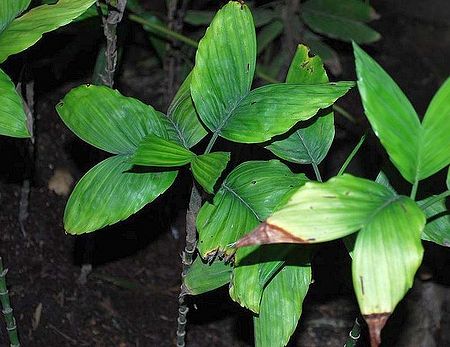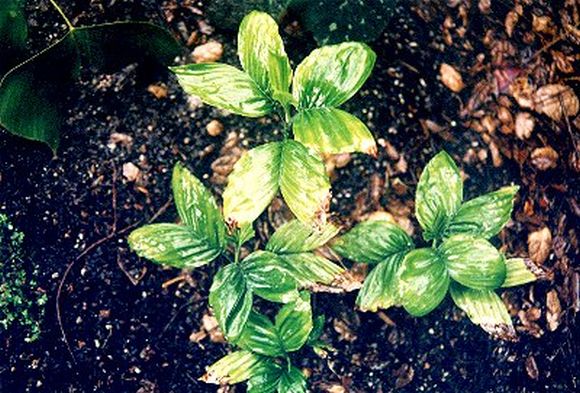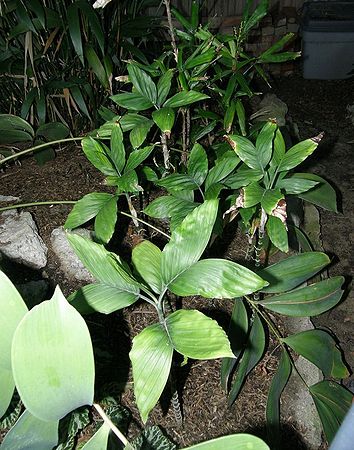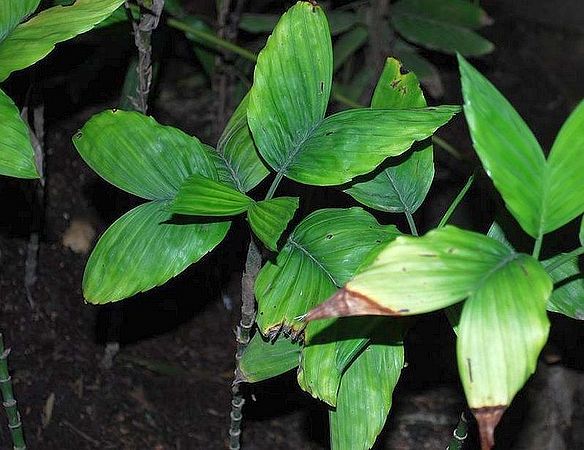Chamaedorea correae
| Chamaedorea (kahm-eh-doh-REH-ah) correae (kor-reh'-eh) | |||||||
|---|---|---|---|---|---|---|---|
 | |||||||
| Scientific Classification | |||||||
| |||||||
| Synonyms | |||||||
|
| |||||||
| Native Continent | |||||||
|
| |||||||
| Morphology | |||||||
| |||||||
| Culture | |||||||
|
| |||||||
| Survivability index | |||||||
|
| |||||||
| Common names | |||||||
|
| |||||||
Contents
Habitat and Distribution
Chamaedorea correae is found in Panamá, Coclé, Colón, San Blas, and Veraguas. Wet forest mainly on the Atlantic slope at or near the Continental Divide; alt. 800-l,000 m elevation.
Description
Habit: solitary, decumbent with prostrate portion longer than erect portion, to 2-3 m long, briefly erect to 1 m tall. Stem: 5-10 mm in diam., creeping, rooting at nodes where touching ground, green, prominently ringed, internodes 5-10 cm long. Leaves: 4-5 per crown, erect-spreading, bifid or sometimes pinnate; sheath to 15 cm long, tubular, obliquely open apically, light green, longitudinally striate-nerved; petiole to 10 cm long, flat and graygreen above, gray-green and rounded below; rachis 5-15 cm long, angled and gray-green above, rounded below and with a pale yellow or light green band extending onto sheath; rachis, petiole, and upper part of sheath densely but minutely White-spotted; blade 15-25 x 20-30 cm, incised apically to 3f4 its length, lobes broadly divergent, 15-25 x 4-12 cm, lanceolate, slightly sigmoid, dull green orgray-green, ± thick, acuminate, 8-10 primary nerves above, exterior margin toothed toward apex, or infrequently blade pinnate with a pair of small basal pinnae, these 8-12 x 1.5-3 cm, lanceolate, sigmoid, acuminate, narrowed basally, 2-3 prominent nerves above. Inflorescences: infrafoliar, emerging well below or behind leaves, erect-ascending; peduncles 10-15 cm long, erect and green to greenish yellow in flower, erect or spreading and red-orange in fruit; bracts 5-6, prophyll 5 mm long, 2nd bract 1 cm, 3rd 2-3 cm, 4th 4 cm, 5th 6-8 cm, 6th 8-10 cm, tubular, abruptly flared apically, longitudinally striate-nerved, acute-acuminate, bifid, uppermost not exceeding peduncle. Staminate with 2-3 rachillae or rarely spicate, to 15-20 cm long, 1.5 mm in diam., erect, finely longitudinally striated. Pistillate spicate or less often forked; bracts similar to
| read more |
|---|
|
those of staminate; rachis or flower-bearing portion to 15-20 cm long, 2 mm in diam., finely longitudinally striated, erect and greenish yellow in flower, erect or spreading and red-orange in fruit. Flowers: Staminate rather densely arranged, 2 x 2.5 mm in bud, subglobose, greenish yellow, just prior to anthesis 2.5 x 2.5 mm, yellowish, ± superficial; calyx 2.5-3 mm across, membranous, lobed, sepals connate in basal 1/2-3/4; petals 2-2.5 x 2.5 mm, rounded-triangular, valvate, only briefly connate basally, spreading apically, acute, obscurely nerved; stamens with filaments very short, anthers 0.75-1.25 mm long, flush against base of pistillode; pistillode 1.5-2 mm high, columnar, broadly lobed apically, flared basally and there adnate to filaments, green or yellowish. Pistillate rather densely arranged, 2 x 2 mm, ovoid-globose, greenish yellow, ± superficial; calyx 1-1.25 x 2.5 mm, deeply lobed, green, fleshy, sepals connate in basal 1/4 petals 2-2.5 x 2 mm, long-triangular, imbricate basally, spreading apically, acute; pistil 2-2.5 x 2 mm, globose, pale orgreenish, styles short, stigma lobes flattened, recurved, pointed. Fruits: 5-8 mm long, ellipsoid-globose, black. (Hodel, D.R. 1992)/Palmweb. Editing by edric. With creeping stems that root at the nodes and thick, somewhat leathery, gray-green leaves, C. correae is one of the most distinctive members of the genus. It inhabits wind-swept, elfin cloud forest near or at the Continental Divide where its long stems creep through the moss-laden litter of the forest floor or are supported on low shrubs. The inflorescences appear on the stem well below or in back of the leaves, often as much as a meter or so. The bright red pistillate inflorescences are quite showy and persist long after the fruits have fallen. Leaves of C. correae from near El Valle, Cocle usually have a broad terminal pair of pinnae with a few, small basal pinnae while those from Veraguas are bifid. At El Cope between El Valle and Veraguas, leaves are intermediate and may be either bifid or pinnate with a large terminal pair and small basal pinnae. C. correae is close to C. guntheriana but the smaller leaves with more narrowly divergent lobes, shorter peduncles, and flowers attaining anthesis in a markedly progressive manner up the axis distinguish C. guntheriana. C. correae may also be confused with C. chazdoniae but the thinner, green blades with fewer nerves, green petioles, and spreading staminate rachillae with cream-colored flowers distinguish the latter species. C. correae has only recently been introduced to a few collections in California, Florida, Hawaii, and Australia. (Hodel, D.R. 1992)/Palmweb. |
Culture
Requires consistently moist soil; do not let dry out between waterings, suitable for growing in containers.
Comments and Curiosities
Chamaedorea are dioecious, male, and female flowers, on separate plants.
Etymology: Honors Mireya Correa, botanist and professor at the University of Panama.
External Links
References
Phonetic spelling of Latin names by edric.
Special thanks to Geoff Stein, (Palmbob) for his hundreds of photos.
Special thanks to Palmweb.org, Dr. John Dransfield, Dr. Bill Baker & team, for their volumes of information and photos.
Glossary of Palm Terms; Based on the glossary in Dransfield, J., N.W. Uhl, C.B. Asmussen-Lange, W.J. Baker, M.M. Harley & C.E. Lewis. 2008. Genera Palmarum - Evolution and Classification of the Palms. Royal Botanic Gardens, Kew. All images copyright of the artists and photographers (see images for credits).
Hodel, D.R.1992. Chamaedorea Palms, The Species and Their Cultivation.The International Palm Society.
- IMAGE GALLERY
Many Special Thanks to Ed Vaile for his long hours of tireless editing and numerous contributions.







